TAPAS.network | 18 September 2024 | Commentary | Phil Goodwin
The Smeed Report on Road Pricing: Still influential after 60 years, but the difficult issues still remain

The idea of ‘pay as you go’ charging for road use has been around for more than half a century , but still only adopted in a handful of situations world wide . The case was lucidly made back in 1964 in the seminal report to the then Ministry of Transport by a panel led by Reuben Smeed. Attractive to many economists and traffic engineering technologists, the same cannot be said for the politicians who need to sign off schemes, observes . Here he explores the uncompleted journey towards the application of road pricing in the UK – and the circumstances in which it might yet happen.
A HOT POLITICAL TOPIC now in Britain is what to do about the impending loss of tax revenue due to the transition, encouraged for environmental reasons, from petrol and diesel vehicles that are subject to duty on the fuel they use, to electric vehicles that are not. Depending on the speed of transition, and what other associated policies are implemented, some £20 billion to £40 billion per year tax revenue is at risk.
In that context, there is a new urgency about alternative methods of charging for road use, an issue whose official hinterland now spans more than half a century. This was the topic for discussion at a recent meeting in London organised by the Road User Charging Forum and the Centre for Transport Studies at University College London. The title was ’60 years since Smeed’, with a focus on re-visiting a modest but profoundly influential Government report, ‘Road Pricing: the Economic and Technical Possibilities’, usually called the Smeed report, after the Chair of the Panel which produced it in 1964. The conference brought together representatives of the young, but rapidly growing, industry of commercial specialists in the production and use of new technology methods of charging for the use of roads, including tolls and congestion charges. Also present were a few veteran academics, politicians and former civil servants whose careers had been focussed on the successive attempts to implement road user charges. I was the opening speaker, and presented an advance summary of this article.
Who was Smeed?
Reuben Smeed (1909-1976) was Deputy Director of the Road Research Laboratory, an institution originally set up by the Government in 1933 as an activity of the Department of Scientific and Industrial Research, DSIR (not the Ministry of Transport) . He was a mathematician, and in the war had worked on operations research for RAF Bomber Command, becoming their chief research officer. After the war he was Deputy Director in the Traffic and Safety Division of DSIR, which later became the Road Research Laboratory, RRL (later adding a ‘T’ for transport to become TRRL, then just TRL, and ultimately sold off to be a private consultancy). It earned a serious reputation in working on the physical performance of roads and the behaviour of traffic using them. Smeed looked too at early methods of forecasting traffic, implications for road planning, and published many original and important papers[1] on traffic and safety.

Reuben Smeed
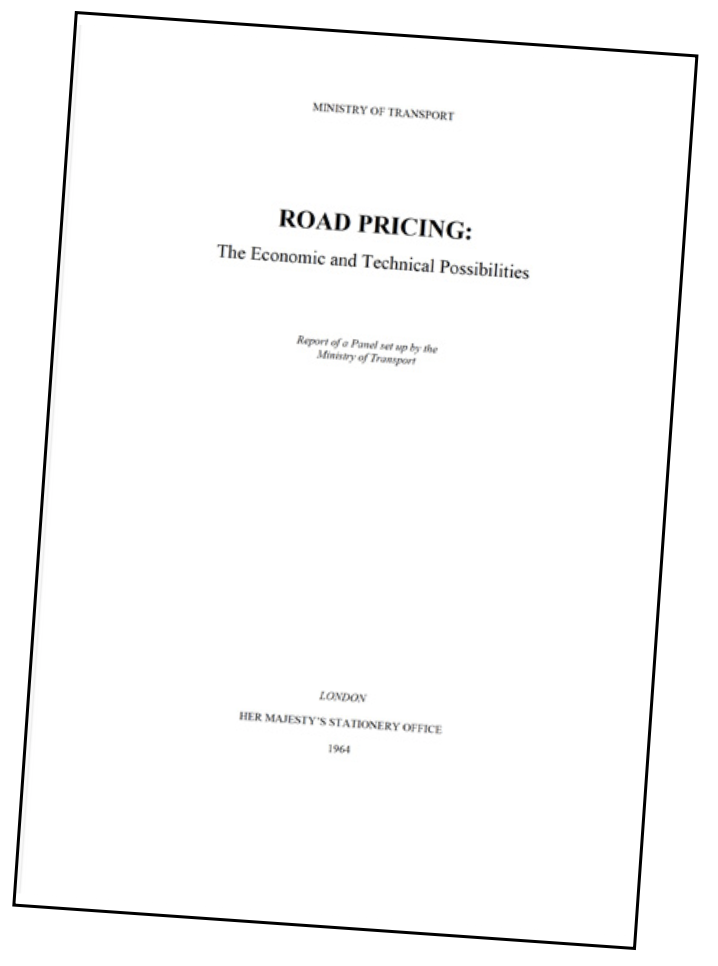
The Smeed Report was published for the Ministry of Transport in 1964
The road pricing study was commissioned in 1962 by Ernest Marples, Minister of Transport, in the Conservative Government of which Harold MacMillan was Prime Minister, though the exact prompt for that initiative remains unclear.
As Deputy Director of the Road Research Laboratory, Smeed was tipped to become Director, but on the report’s publication two years later, in 1964, the then Conservative Prime Minister, Sir Alec Douglas Home, hated it. (It might have been interesting if it had been delivered a few months later when Labour had become the Government under Harold Wilson: Barbara Castle, later the Minister of Transport, was said to have looked at it favourably, though Wilson not). As it was, Smeed left RRL, spent a short spell at the Ministry of Agriculture, and soon moved to University College London , where he became the first Professor of Traffic Studies and set up the UCL Research Group in Traffic Studies which later became the influential Centre for Transport Studies. It was a career shift which he evidently enjoyed, but had not, I think, been his plan. I was one of his first group of PhD students, in 1967, and stayed there for seven years. It is telling that Smeed rarely said anything about road pricing, and as far as I know did no further work on the subject.
The Smeed Report- what it said
The Smeed report itself was a remarkable piece of comprehensive, scientific civil service writing, the template for many later such studies. It is still a pleasure to read, though the technologies discussed now look quaint. It had 31 references, mostly written by members of its later to be illustrious panel, including 12 internal RRL reports labelled as ‘unpublished’[2]. These future star leaders of transport thinking on the panel included Michael Beesley, Christopher Foster, John Wardrop (one of the key figures in the development of traffic science), and Michael Thompson as Secretary.
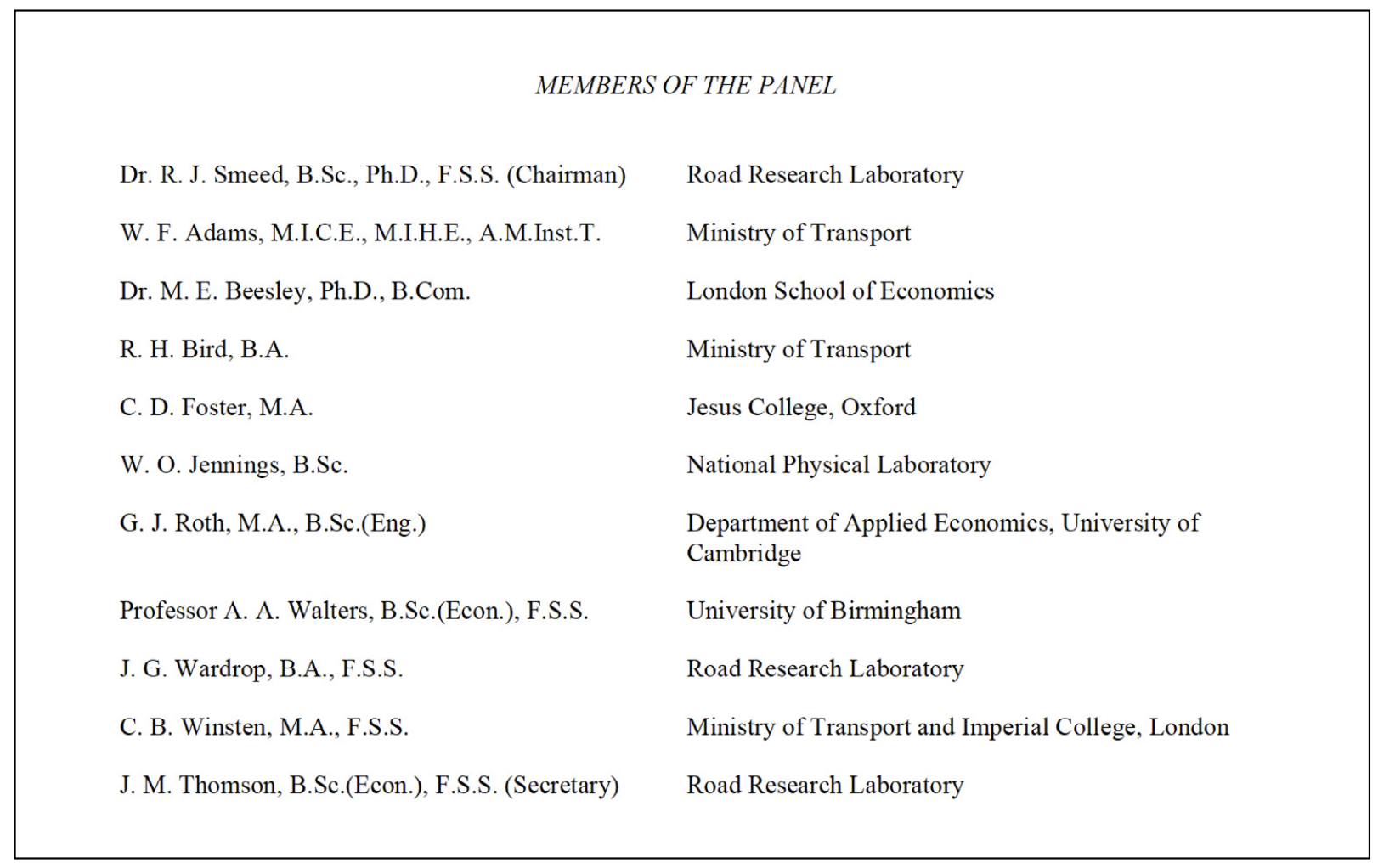
The Smeed panel that reported to the Ministry of Transport in 1964
The panel’s essential argument was that road users should pay the additional costs which their journeys impose on others. It suggested that this would bring net economic benefits of £100-£150m a year from the reduction in congestion, which would now equate to about £2 billion to £3 billion a year just allowing for inflation. However, later estimates have been much bigger, due to the growth of traffic and congestion costs since then, which was in part because the Smeed recommendations were not implemented.
In retrospect, the only mistake in my view, of the Smeed work, was a piece of orthodox economic theory which took decades to put right.
The theoretical proposition was that overall consumer welfare would be increased by deterring those trips whose benefits were less than the costs of congestion imposed on others. (The same would apply to environmental and other costs). This was shown in an Appendix by a few pages of calculus.
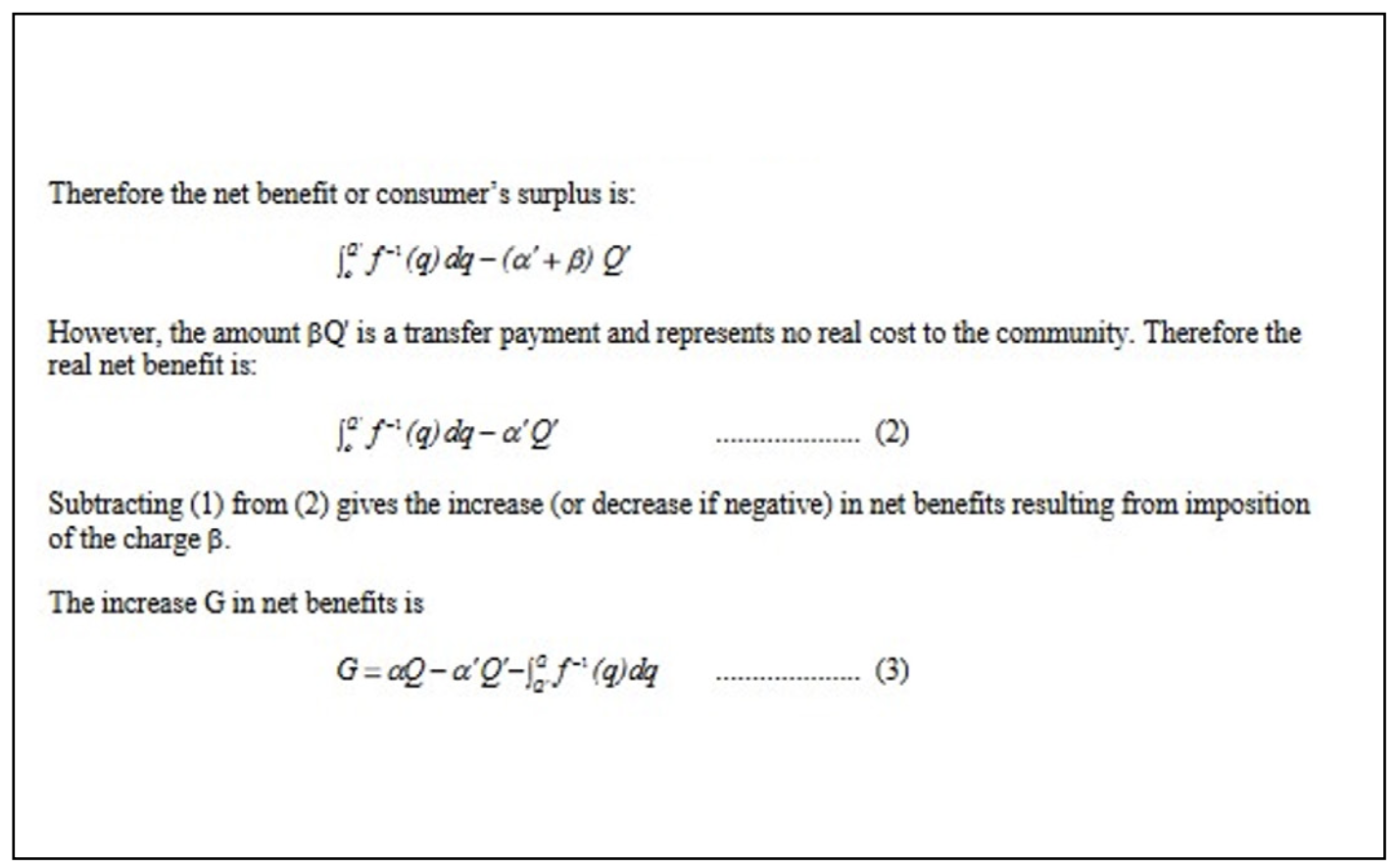
The Smeed Report’s theoretical proposition was that overall consumer welfare would be increased by deterring those trips whose benefits were less than the costs of congestion imposed on others. This was shown in an Appendix by a few pages of calculus.
It argued that the amount of revenue collected from the charge, net of the costs of collection , is itself a transfer payment, and ‘represents no real cost to the community’. The welfare loss to those who paid was exactly balanced by the welfare gain to whoever the net revenue was spent on.
This logic means that in calculating benefits it is not necessary to decide whether to use the revenue to reduce taxes, or spend more on roads, or other transport measures, or health, or defence. The implications are that considerations of equity and distribution are in effect irrelevant to the calculation of benefits. Alan Walters[3] (one of the panel) had written
“Problems of the distribution of income – who would and would not be harmed by the policy advocated – will not be considered here. The general ramifications of such a policy are reasonably clear but the detailed analysis would be cumbersome and boring”
This approach (though not so dismissively expressed) also underpinned the Treasury’s traditional opposition to hypothecation of individual taxes to specific purposes, because it reduces flexibility in deciding public spending priorities, and reduces overall welfare. Indeed motoring taxes were initially applied to a ‘road fund’, the hypothecation of which was famously challenged by Winston Churchill, then Chancellor of the Exchequer, from the second half of the 1920s. The road fund was soon taken into the national budget in 1927. Nearly a century later, that debate has become a folk memory, whose traces are still seen when there are lobbying complaints that the money collected ‘from motorists’ is not applied ‘for motorists’, i.e., on roads, and was for a while revived in 2018.
But the theory of tax revenues’ ‘neutral’ deployment was flawed. A large proportion of the calculated benefit was, in effect, ‘locked up’ in the tax collected, and the impact of road user charging on congestion would also be influenced by the differential demand responses of those who were charged, and those whose congestion was reduced, and therefore issues of ‘who pays, who benefits’ were inextricably bound up with effects on congestion and the mobilisation of political forces, and public opinion, for and against.
As it happened, Peter Jones and I made exactly this point, 35 years ago, in a report for the European Conference of Ministers of Transport:[4]
“Whether implicitly or explicitly, road pricing can only form one element of a package of measures designed to tackle urban traffic congestion – and only then if the public perceive it as a ‘necessary’ tool for traffic management. This is likely to arise where it is marketed as a ‘total system’ with the money raised being hypothecated for road building or public transport support; or where congestion is so bad that there is an acceptance that drastic restraint measures are called for”.
This point may seem trivially obvious now. But it wasn’t then. That is one mark of how much things have changed. In a much later paper in the same series by ECMT, now renamed the OECD International Transport Forum, Jillian Anable and I argued further that the welfare and distributional consequences of road pricing could only be determined as the net effects of both the pricing system, and the supporting or compensating measures associated with it[5]. A pricing system with its revenue hypothecated for road improvement would be quite different from one where it was hypothecated for public transport improvements, or associated with a reallocation of road capacity, for example. It would also be necessary to look at the incidence of the burdens of external costs, differentially by location, taking account of the range of choices of alternative methods of transport or pattern of activities, , and opportunities for dynamic adaptation of travel patterns over time as short terms constraints would evolve at points of change in life cycle, family circumstances, and the success and failure of companies. To describe this as ‘cumbersome and boring’, as did Walters, seems very short sighted.
But back in 1989, twenty five years on from Smeed’s report, much bigger changes were in train. Prime Minister Margaret Thatcher’s Government’s ‘Roads for Prosperity’ White Paper had been proudly described as the ‘biggest road programme since the Romans’, but by 1991 its arithmetic and strategy had been challenged by local authorities and professionals, as recorded in a report of the Oxford Transport Studies Unit, supported by the Rees Jeffreys Road Fund, ‘Transport: the New Realism’[6]. In 1994 the DfT’s traffic calculations were further challenged by the Standing Advisory Committee on Trunk Road Appraisal (SACTRA)’s report on induced traffic[7]. This led to a partial convergence of Conservative and Labour policy, the election of a Labour Government, in 1997, installation of its Deputy Prime Minister, John Prescott, as Secretary of State for Environment , Transport and the Regions, and a White Paper ‘A New Deal for Transport: Better for Everyone’ in 1998, proposing a new direction in transport policy. In Prescott’s introduction to the White Paper, he gave credit to the shift in Conservative thinking, producing consensus for a fundamental shift in priorities from building road capacity in an impossible effort to outpace the forecast increase in traffic, to the management of traffic demand and the provision of better alternatives.
I should note that John Prescott had appointed a panel of advisers to help write this White Paper, which I chaired, and helped to formulate its transport strategy and approach to legislation. It included firm proposals regarding road user charging by Government for the first time since the Smeed report 34 years earlier.
The approach chosen was based on enabling legislation to allow local road pricing, to be implemented by local authorities, not Government, if they chose to do so. The revenue would be explicitly hypothecated, to transport purposes , but mainly not to road building. (This was supported by an agreement between Prescott and Gordon Brown, the Chancellor, that the prices were counted as charges for a service, not strictly ‘taxation’ as suce, and therefore did not offend the Treasury’s continued dislike of hypothecation).
We expected that around 20 cities would want to join in, but in the event there were only two main successes. In London Mayor Ken Livingstone, elected in 2000, implemented Congestion Charging in February 2003, his officials having been given a brief ‘I don’t want you to design me a perfect system. I want a system that can be implemented during my administration [8].’And Nottingham, with less publicity, used the new powers to introduce workplace parking charges, with the same objectives, and lasting success.
So whilst this represented a very important step in actual implementation of ‘road pricing’ it was not at the scale and pace that had been hoped for.
Another step forward came in the 2002-2003[9] session of the Parliamentary Select Committee on Transport, which carried out an enquiry on Urban Charging Schemes. It called upon the Government to contribute to a ‘national debate’ on Congestion Charging.
This in turn helped to trigger a very large feasibility study carried out by the Department for Transport and published in 2004. It reported, in summary, that a national system of road pricing was ‘becoming feasible’; that this would meet the Government’s transport objectives; that there was a need to promote a greater degree of consensus; and that there were some initial steps which could be taken now[10].
Of course the technology had moved on hugely, and the report suggested that this could probably be implemented in 10 years. It is worth noting that the ‘10 year’ horizon figure, which has been a rather enduring estimate before and since, is not really a technical consideration , but a political one. Ten years effectively means ‘not in this lifetime of this Government, and not in the next one, but maybe the one after that’- an electoral escape clause in any controversial policy area of this kind. See also Glaister (2014)[11].
One section of the 2004 report, titled ‘Getting used to road pricing’ made a comparison of the evolution of public opinion[12] about the idea, in the implementation of pricing in London, Trondheim and Stockholm. It noted:
“Prior to the introduction of the London Congestion Charge, public opinion was equivocal. Findings from a Transport for London tracker survey demonstrated that after introduction, public opinion shifted in favour of the scheme, with opposition levels falling. Findings from various other public opinion polls taken in 2004 indicate that support for the congestion charge has increased further. Additionally, in late 2003, over two thirds of people agreed that the charge had been successful in reducing congestion.
In Trondheim, public opinion was initially opposed to the introduction of a road pricing scheme, with 72 per cent against, dropping to 48 per cent two months after launch in 1991 and reducing to 36 per cent by 1996.
In Stockholm, a trial city centre congestion charging zone is due to start in Spring 2005. The city authorities have announced their intention of holding a referendum in September 2006 to decide whether or not it should be permanent. Voters will have had over a year’s experience of the scheme in practice rather than in abstract”.
This pattern of opinion ‘coming round’ was summed up later in a much-reproduced figure that I called the ‘gestation’ process for road pricing, in a column I wrote in Local Transport Today in 2006[13]. Its point is that public opinion has to be seen as a systematic dynamic process, not a random moment or movement of opinion polls, and this affects the strategy for timing and sequence of implementation. Its application includes the experience of initiating a pricing system explicitly for a trial or experimental period pending a final decision, which would only be taken after people had had experience of what it was actually like in operation.
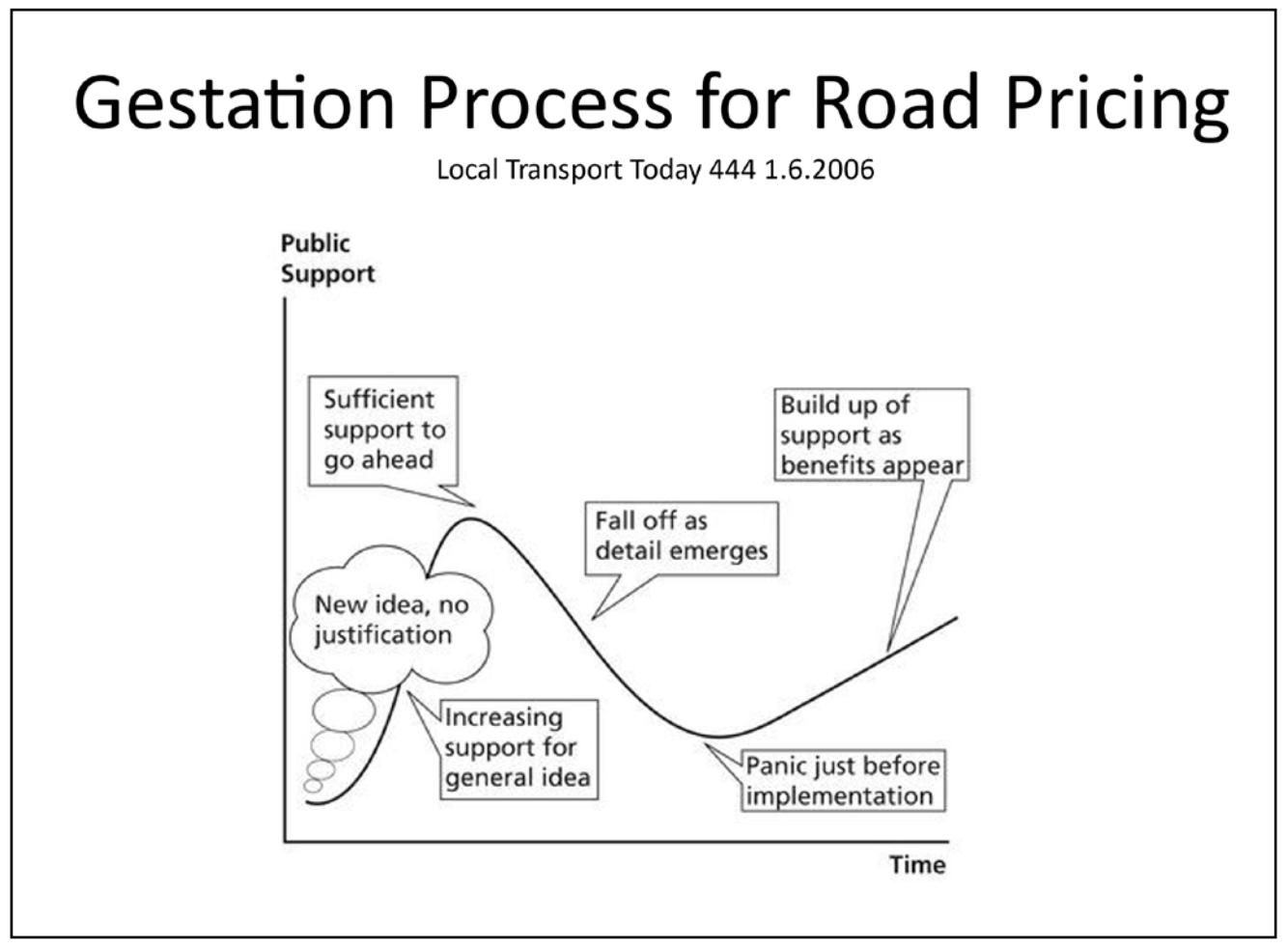
How public reactions change along the pathway to road pricing implementation as depicted in my article for LTT in 2006
The Transport Committee in Parliament gave a very favourable response to the 2004 DfT Road Pricing feasibility study, and emphasised again the question of the relationship between charging and the broader strategic approach to transport as a whole[14].
As the Committee put it:
“The Department for Transport anticipates a 30 per cent increase in road traffic (compared to 2000 levels) by 2015. Congestion already has a strangle-hold on many of our towns and cities at rush hour and on important parts of the strategic road network.
We welcome the Government’s acknowledgement that although some new road infrastructure may be needed, we cannot simply build our way out of the congestion problems we face. There is a broad consensus that some form of demand management will be necessary as part of a package of measures to improve conditions on the road network. Road pricing has the potential to reduce congestion and to ensure that the price of road transport correctly reflects the wider costs of road use. We welcome the fact that the Secretary of State for Transport is leading the debate. If the cost of the scheme can be brought in line with its benefits, and if the potential impacts on road safety and social inclusion can be minimised, road pricing should be introduced. However, road pricing is not an end in itself: it must contribute to social and economic objectives such as sustaining vibrant, accessible and economically active urban centres.”
The Eddington Report - and a significant Annex to it
There certainly seemed to be considerable momentum building up. In 2006 another big Government study on transport , commissioned from Sir Rod Eddington, reported that road pricing would be good for the economy as a whole, not just traffic congestion, and also that large road projects gave poorer value for money than many smaller and more sustainable alternatives.
This finding was later confirmed by quite large numbers of other studies[15], always broadly welcomed, but never yet quite finding their way into a sufficiently large reallocation of spending. A particularly significant approach was taken in a research annex to the Eddington Report.
The Eddington Study itself had four volumes and a number of technical appendices, one of which, ‘Transport Demand to 2025 & the Economic Case for Road Pricing and Investment’, included a new and sensitive finding. It is a rather obscure report as input to the Eddington study , written by DfT officials using the DfT national forecasting model. It was published initially by the Treasury, and since available online, in the DfT archives, though without a cover page, or authorship, or any trace of DfT or Treasury logos[16]. Its caveat states (in para 2)
“This report represents part of the wide ranging evidence considered by the Eddington Study. It focuses on results from the Department for Transport’s National Transport Model (NTM), and combines this with evidence from real interventions from across the UK. This body of work was requested by the Eddington study team and fed into the evidence base of the Eddington study; it does not necessarily represent Departmental policy.”
The work considered the effects of a nationwide road pricing system, at prices set to make the price of travel cover the marginal social cost of travel. It suggested that in that case, the amount of new road capacity suggested as needed from 2015 would be up to 80% less than would be proposed under the existing price structure.
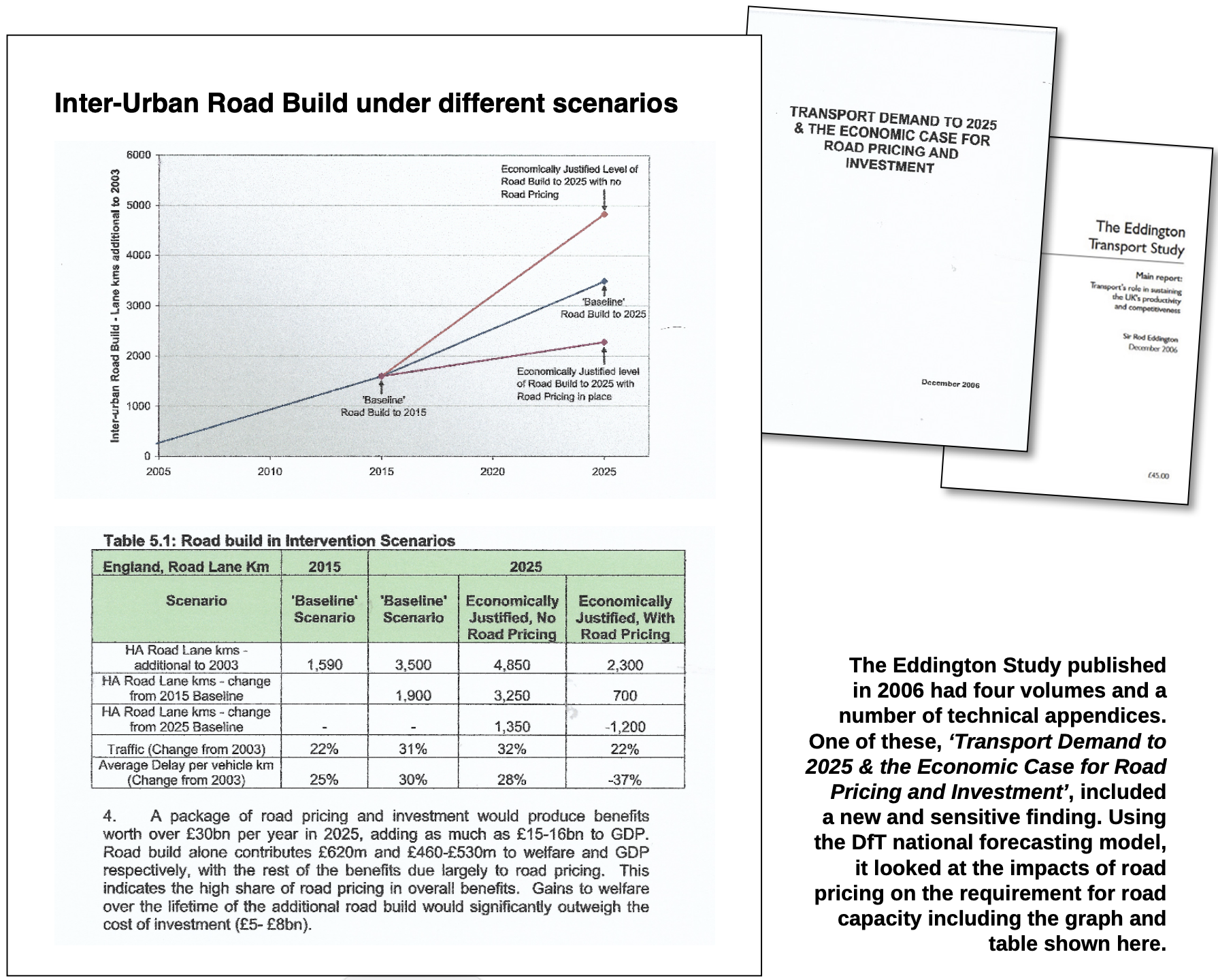
Most interestingly, this result was not mainly due to the absolute reduction in total traffic (which, in the modelling used, was forecast to be small) but to a change in traffic growth and especially shifts in time of day of travel resulting from the differential charges applied.
All such analyses have caveats, of course, but this deduction was entirely sensible. I am myself strongly persuaded it is time now for that work to be brought out of its obscure archive, and updated. Its acceptance, in broad terms, is arguably a fundamental condition of progress in the road user charging policy space. The paper’s unnamed authors, whoever they were, deserve credit.
In some ways that report was the high point of support from road pricing for over a decade, and in 2018 an entirely different approach was announced by the Government , promising that all the proceeds of Vehicle Excise Duty, (described as ‘the road tax’), from 2020 to 2025 would be allocated to Highways England, in ‘the biggest-ever’ single investment in England’s largest roads, reminiscent of the claims for Margaret Thatchers road programme 30 years earlier. This pledge resulted in a number of additional controversial schemes being added to the increasingly controversial list of road proposals still to be resolved. Although appearing to support the principle of hypothecation of tax revenue, it failed to resolve any of the financial or transport strategic policy issues that the road programme as a whole, and some individual schemes, triggered.
Meanwhile, in 2020-21 the House of Commons Transport Committee took up its concerns about a more fundamental issue in policy – the switch to electric and other Zero emission vehicles, encouraged mainly for environmental reasons, and its relationship with road user charging . This perspective seemed far more congruent with earlier (and, as it proved, later) policy directions in respect of the ‘market signals’ and taxation that should apply to road users.
Reconciling complexity in design and speed in implementation?
I want to refer here to the evidence[17] submitted by a group of Professors – Jillian Anable, Glenn Lyons, Greg Marsden, Graham Parkhurst and myself - which sought to summarise the problematic combined implications of the research on road user charging, that we and our colleagues had been pursuing separately, in recent years .
This we summarised as follows.
“We recognise that there seems an essential contradiction in our approach. We are arguing that road user charging needs to have more complex objectives and design, with more dimensions and constraints than have been taken into account previously. At the same time, we are proposing that a new system needs to be implemented swiftly and sensitively. It is inevitable that the new system will not be perfect from day one. That means that the greatest thought needs to be given to an aspect which is rarely given prominence in transport planning, and sometimes not considered at all: the sequence and timing of changes. A new system must be initially as simple as possible: the complications can come later, therefore it must be flexible, and be accompanied by processes for monitoring and revision which are transparent and thought about in advance. Even at the simplest stage, it must not run counter to its objectives.
There are views that the political advantage is in leaving things as they are, or only making the minimum changes that would address the short-term problems, especially at a time of social and economic difficulty in the last year. But times of real crisis highlight the need for real change. Reforms are necessary anyway due to Brexit and the socioeconomic upheaval of COVID. Climate change has the prospect to dwarf even those impacts. Climate policy, economic efficiency and equity now make a strong case that the question should not be about if, but how, we transition to a fairer and more effective way of paying for how we travel”.
That conclusion , I think, is an approach which is entirely compatible with the stated priorities of the new Government just elected this year, and if they were prepared to run with it there is greater chance that it could result in a successful application of both their environmental and financial objectives.
Conclusions: Four Axioms
I hope, in reading this article, you will have shared my journey is seeing where the discussion of road pricing has come over the sixty years from, the Smeed report in 1964, and where this leaves us now. I am sure we can learn from the twists and turns on the way, and to that end I would suggest four axioms that may help us in going forward:
First Axiom: It is a paradox to plan to use road pricing to fund a road programme which would not be necessary if you had road pricing.
Second Axiom: Road Pricing is not inevitable. It would be foolish beyond belief to delay other practical, sustainable and sensible policies on the assumption that road pricing is imminent. The application of demand management measures will need to be more intense if the price signals do not support them.
Third Axiom: Road pricing is possible, and likely. Logically we should therefore meanwhile include ‘a future with road pricing’ as a key possible scenario in re-appraising current and inherited major projects and policies.
Fourth Axiom: A future without road pricing presents serious problems which are not easier to solve than the problems of implementing it.
References and Links
-
One of which, An Exploratory Comparison of the Relative Advantages of Cars and Buses in Urban Areas, by R J Smeed and J G Wardrop, showed that travel would be faster if a greater proportion of people would transfer from cars to buses. I read this as a student in 1966 and it was a key influence on my decision to apply to join Smeed, and on my own later work.
-
These — and in fact most of the historically important documents and reports referred to in this article — would be classed as ‘grey’ references in the self-serving citation counts classified by commercial academic publishers. This underlines my conviction that such categorisation does not properly reflect the influence of research material in transport that does not emenate from inside academia , as I have argued in an earlier LTT and Tapas contribution ‘From black and white to shades of grey – the flawed world of expert knowledge dissemination in transport’. You can read that article here: https://tapas.network/32/goodwin.php
-
Walters, A. A. (1961) The theory and measurement of private and social cost of highway congestion. Econometrica, 29, pp. 676-99
-
Goodwin and Jones (1989) Road Pricing: the political and strategic possibilities, European Conference of Ministers of Transport, Systems of Infrastructure Cost Coverage, Round Table 80 https://www.oecd-ilibrary.org/transport/systems-of-road-infrastructure-cost-coverage_9789282104781-en
-
Anable J & Goodwin P (2018) Assessing the distributive effects of a congestion charge using a synthetic population model, Discussion Paper, OECD International Transport Forum, https://www.itf-oecd.org/sites/default/files/docs/net-overall-distributive-effect-congestion-charge.pdf
-
Goodwin P, Hallett S, Kenny F, & Stokes G (1991) Transport, the New Realism, Transport Studies Unit, University of Oxford, re-issued https://tapas.network/rr2/downloads/1991%20goodwin-hallett-kenny-stokes%20Transport%20the%20New%20Realism%20rerelease%202012.pdf
-
SACTRA (1994) Trunk Roads and the Generation of Traffic, Department of Transport, https://bettertransport.org.uk/wp-content/uploads/legacy-files/trunk-roads-traffic-report.pdf
-
The initial effects of the charge produced rather more reduction in traffic than the main forecasts made in advance, and consequently a rather smaller revenue, though both were within the range of possibilities expected. The methods used, in my opinion, were subject to a degree of underestimation of the demand elasticities (as had also been the case in calculation of induced traffic from road building), a modelling issue which has still not been fully resolved).
-
House of Commons Transport Committee, ‘Urban Charging Schemes’, First Report of Session 2002-03, 5 February 2003, HC 390-I
-
Department for Transport 2004) Feasibility Study of Road Pricing Full Report https://www.london.gov.uk/sites/default/files/gla_migrate_files_destination/DfT%20road%20pricing%20feasibility%20study.pdf
-
Glaister S (2014) The Smeed Report at 50 - will road pricing always be ten years away? Smeed Memorial Lecture, , University College London, https://www.ucl.ac.uk/transport/sites/transport/files/UCL-smeed-memorial.pdf
-
Surveys of public opinion have been a recurrent thread in Government and academic work on road pricing, for example Owen, R., Sweeting, A., Clegg, S., Musselwhite, C. and Lyons, G. (2008). Public acceptability of road pricing. Final report for Department for Transport, May. See also HoC Library briefing note https://commonslibrary.parliament.uk/research-briefings/sn01482/
-
Goodwin P (2006) The gestation process for road pricing schemes, Local Transport Today No. 444, 1.6.2006 discusses the origin of this figure: I had not been able to find its first use. The annotations were mine but the functional form seems to have been developed informally and transmitted in unpublished media.
-
House of Commons Transport Committee Road Pricing: the Next Steps (2005) https://publications.parliament.uk/pa/cm200405/cmselect/cmtran/218/21803.htm
-
One compilation was published by the Commission for Integrated Transport, set up by John Prescott as one of its last reports before its abolition by the new Conservative-led Coalition Government under David Cameron in his ‘bonfire of the quangos’. I have not found the CfIT report itself in any archives, but its source material is collated in Goodwin, P (2010) Opportunities for improving transport and getting better value for money by changing allocation of public expenditure to transport, https://webarchive.nationalarchives.gov.uk/20110304134246/http://cfit.independent.gov.uk/pubs/2010/tco/think03/index.htm
-
Transport Demand to 2025 & the Economic Case for Road Pricing and Investment (2006) (publication details and authorship not stated) DfT archive https://web.archive.org/web/20080809030750/http:/www.dft.gov.uk/about/strategy/transportstrategy/eddingtonstudy/researchannexes/researchannexesvolume3/transportdemand
-
Transport Committee Inquiry on Zero emission vehicles and road pricing.(2021) Written evidence https://committees.parliament.uk/writtenevidence/22828/html/
Professor Phil Goodwin is Emeritus Professor of Transport Policy, University College London and University of the West of England. He was head of the Transport Studies Unit at Oxford University for 16 years, before moving to UCL in 1996.
This article was first published in LTT magazine, LTT899, 18 September 2024.
You are currently viewing this page as TAPAS Taster user.
To read and make comments on this article you need to register for free as TAPAS Select user and log in.

Log in